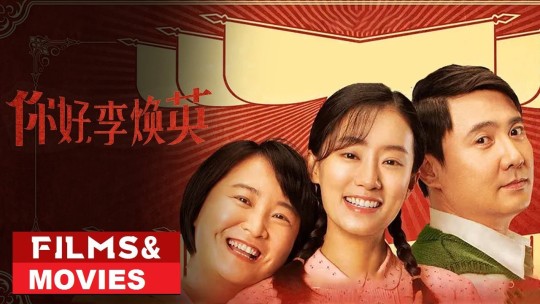#▷你好,李焕英▷线上看完整版(2021)在线观看 HiMom [1080P]
Explore tagged Tumblr posts
Text
▷你好,李焕英▷线上看完整版(2021)在线观看 Hi,Mom [1080P]
▷你好,李焕英▷线上看完整版(2021)在线观看 Hi,Mom [1080P]
【你好,李焕英 】 線上看小鴨完整版-[2021,Hi, Mom ]-在線觀看電影~觀看電影完整版~你好,李焕英 完整版本(2021-HD)線上看一觀看電影在線小鴨 ➥ 你好,李焕英 週年紀念作品【你好,李焕英】今天上映!威秀獨家電影套餐.全台同步推出!
◉ 在线观看 :|✮☛ https://watch.playmovies.stream/zh/movie/758891/hi-mom
◉ 在线观看 :|✮☛ https://bit.ly/3qCulF3

你好,李焕英 Hi, Mom (2021) 发布日期: 2021-02-12 运行时间: 128 分钟 类型: 剧情, 喜剧 明星: Jia Ling, Shen Teng, Chen He, Zhang Xiao-fei 导演: Jia Ling, Jia Ling 2001年的某一天,刚刚考上大学的贾晓玲经历了人生中的一次大起大落。一心想要成为母亲骄傲的她却因母亲突遭严重意外,而悲痛万分。在贾晓玲情绪崩溃的状态下,竟意外的回到了1981年,并与年轻的母亲李焕英相遇,二人形影不离,宛如闺蜜。与此同时,也结识了一群天真善良的好朋友。晓玲以为来到了这片“���阔天地”,她可以凭借自己超前的思维,让母亲“大有作为”,但结果却让晓玲感到意外...... 你好,李焕英在线, 你好,李焕英下载, 哆啦a梦伴我同行在线,完整版小鴨 你好,李焕英线上看, 哆 啦 a 梦 剧场版 之 伴我同行, 你好,李焕英线上看, 你好,李焕英夢在线, 你好,李焕英夢完整版, 你好,李焕英 夢 线 上看, 你好,李焕英 完整電影版HD, 你好,李焕英 完整版, 你好,李焕英 澳門上映, 你好,李焕英 2021上映, 你好,李焕英 HD線上看, 你好,李焕英 線上看小鴨, 你好,李焕英 电影完整版, 你好,李焕英 線上看下載, 你好,李焕英 2021 下載, 你好,李焕英 線上看完整版, 你好,李焕英 線上看完整版小鴨, 你好,李焕英 (2021)完整版本, 你好,李焕英 |1080P|完整版本, 你好,李焕英 线上看(2021)完整版, 你好,李焕英 線上看(2021)完整版, 你好,李焕英 線上看電影(2021), 你好,李焕英 2021年再次觀看電影, 你好,李焕英 線上看|2021上映|完整版小鴨|線上看小鴨|, 你好,李焕英 上看, 你好,李焕英 主題曲, 你好,李焕英 小鴨影音, 你好,李焕英 線上小鴨, 你好,李焕英 完整版本, 你好,李焕英 香港上映 你好,李焕英 線上看小鴨影音 你好,李焕英 2021 線上看 你好,李焕英 在线 你好,李焕英 1080P 下載 你好,李焕英 免費線上看電影 你好,李焕英 电影在线2021年 你好,李焕英 (2021)在线观看 你好,李焕英 [2021]观看和下载 你好,李焕英 [2021,HD.1080P]观看和下载

Film, also called movie, motion picture or moving picture, is a visual art-form used to simulate experiences that communicate ideas, stories, perceptions, feelings, beauty, or atmosphere through the use of moving images. These images are generally accompanied by sound, and more rarely, other sensory stimulations.[1] The word “cinema”, short for cinematography, is often used to refer to filmmaking and the film industry, and to the art form that is the result of it.
❏ STREAMING MEDIA ❏
Streaming media is multimedia that is constantly received by and presented to an end-user while being delivered by a provider. The verb to stream refers to the process of delivering or obtaining media in this manner.[clarification needed] Streaming refers to the delivery method of the medium, rather than the medium itself. Distinguishing delivery method from the media distributed applies specifically to telecommunications networks, as most of the delivery systems are either inherently streaming (e.g. radio, television, streaming apps) or inherently non-streaming (e.g. books, video cassettes, audio CDs). There are challenges with streaming content on the Internet. For example, users whose Internet connection lacks sufficient bandwidth may experience stops, lags, or slow buffering of the content. And users lacking compatible hardware or software systems may be unable to stream certain content. Live streaming is the delivery of Internet content in real-time much as live television broadcasts content over the airwaves via a television signal. Live internet streaming requires a form of source media (e.g. a video camera, an audio interface, screen capture software), an encoder to digitize the content, a media publisher, and a content delivery network to distribute and deliver the content. Live streaming does not need to be recorded at the origination point, although it frequently is. Streaming is an alternative to file downloading, a process in which the end-user obtains the entire file for the content before watching or listening to it. Through streaming, an end-user can use their media player to start playing digital video or digital audio content before the entire file has been transmitted. The term “streaming media” can apply to media other than video and audio, such as live closed captioning, ticker tape, and real-time text, which are all considered “streaming text”.
❏ COPYRIGHT CONTENT ❏
Copyright is a type of intellectual property that gives its owner the exclusive right to make copies of a creative work, usually for a limited time.[1][2][3][4][5] The creative work may be in a literary, artistic, educational, or musical form. Copyright is intended to protect the original expression of an idea in the form of a creative work, but not the idea itself.[6][7][8] A copyright is subject to limitations based on public interest considerations, such as the fair use doctrine in the United States. Some jurisdictions require “fixing” copyrighted works in a tangible form. It is often shared among multiple authors, each of whom holds a set of rights to use or license the work, and who are commonly referred to as rights holders.[citation needed][9][10][11][12] These rights frequently include reproduction, control over derivative works, distribution, public performance, and moral rights such as attribution.[13] Copyrights can be granted by public law and are in that case considered “territorial rights”. This means that copyrights granted by the law of a certain state, do not extend beyond the territory of that specific jurisdiction. Copyrights of this type vary by country; many countries, and sometimes a large group of countries, have made agreements with other countries on procedures applicable when works “cross” national borders or national rights are inconsistent.[14] Typically, the public law duration of a copyright expires 50 to 100 years after the creator dies, depending on the jurisdiction. Some countries require certain copyright formalities[5] to establishing copyright, others recognize copyright in any completed work, without a formal registration. It is widely believed that copyrights are a must to foster cultural diversity and creativity. However, Parc argues that contrary to prevailing beliefs, imitation and copying do not restrict cultural creativity or diversity but in fact support them further. This argument has been supported by many examples such as Millet an-Watch!- Jumanji: Level One — full (2021) — Movie HD Denmarkd Van Gogh, Picasso, Manet, and Monet, etc.[15]
❏ GOODS OF SERVICES ❏
Credit (from Latin credit, “(he/she/it) believes”) is the trust which allows one party to provide money or resources to another party wherein the second party does not reimburse the first party immediately (thereby generating a debt), but promises either to repay or return those resources (or other materials of equal value) at a later date.[1] In other words, credit is a method of making reciprocity formal, legally enforceable, and extensible to a large group of unrelated people. The resources provided may be financial (e.g. granting a loan), or they may consist of goods or services (e.g. consumer credit). Credit encompasses any form of deferred payment.[2] Credit is extended by a creditor, also known as a lender, to a debtor, also known as a borrower.
0 notes